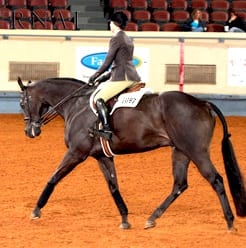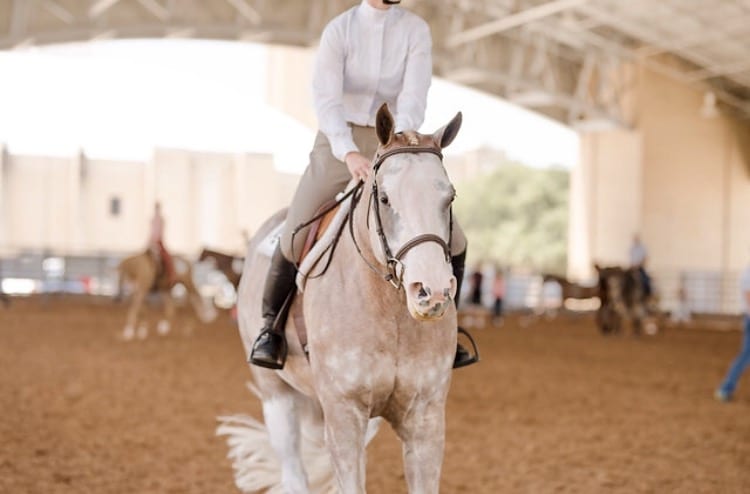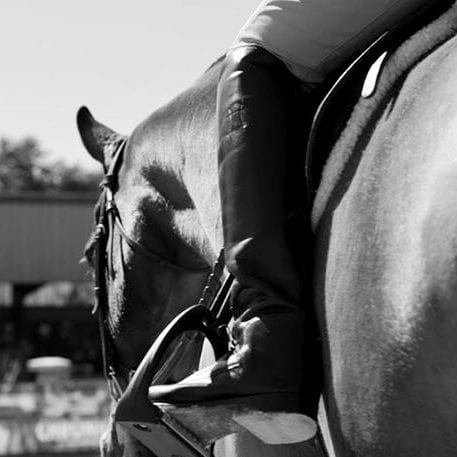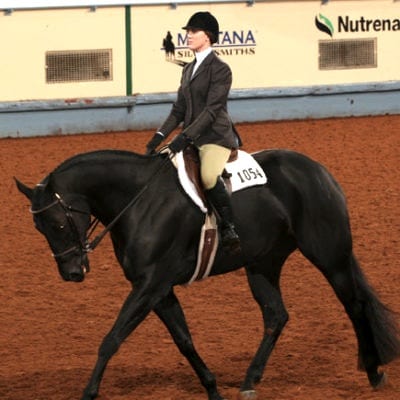Watching an almost flawless English equitation pattern may make one in awe of how quickly an accomplished rider picks up their diagonals correctly without looking. However, one missed beat, and it can be death to a high score. To the bane of many judges and inexperienced riders, missing the correct diagonal can leave one grimacing in frustration. We spoke with AQHA Judge and Silver medalist in dressage, Carla Wennberg of St. Andrews University, about the difficulties of diagonals.
A Balancing Act
While a beginner rider is taught what the correct diagonal is, few are shown why it is necessary to post at the trot, other than it makes riding this gait much more comfortable than sitting it. A proper trot has lift and suspension, meaning the horse must thrust its legs in a two-beat rhythm, ideally taking the momentum upward and forward, almost hanging, floating in the air.
Wennberg, who resides in Laurinburg, North Carolina, explains the necessity of a correct diagonal with regards to producing the best movement in the horse. She states, “Correct Diagonals are for balance. In a curve line, circle or arc, the horse takes a slightly more extended step with the outside leg. Because of a rider’s weight, to ride with the outside leg is correct to keep the horse in balance.
When you ride the wrong diagonal in a curve or circle, the horse must compensate for the weight. Therefore, it is likely in a circle or curve, to lean in.” If a horse leans in for a while on a curve, they are likely to drop their inside shoulder and not produce as long-strided a gait as otherwise obtained by a horse that is standing underneath themselves.
Post It Notes
 The proper post is a rhythmic, timed motion in connection with the horse’s stride. Not only does a good rider obtain the correct diagonal efficiently, but they must also post in a precise manner to maintain balance. Wennberg accentuates passionately, “A rider must have a strong lower leg, meaning, weighted heels and feel of the inside calf against the rib cage, to secure the upper body in balance. So, posting is a forward movement, not straight up and down. I teach upper body slightly inclined forward and posting up and down in motion.” She clarifies that a rider, “should never need hands for balance, just feel to the mouth for adjustments of balance, or what we call a half halt.”
The proper post is a rhythmic, timed motion in connection with the horse’s stride. Not only does a good rider obtain the correct diagonal efficiently, but they must also post in a precise manner to maintain balance. Wennberg accentuates passionately, “A rider must have a strong lower leg, meaning, weighted heels and feel of the inside calf against the rib cage, to secure the upper body in balance. So, posting is a forward movement, not straight up and down. I teach upper body slightly inclined forward and posting up and down in motion.” She clarifies that a rider, “should never need hands for balance, just feel to the mouth for adjustments of balance, or what we call a half halt.”
Riders who are not confident in picking up their diagonals correctly are often at an immediate disadvantage. Does one look down and be sure one has the correct diagonal or does one just guess, hoping they picked the right shoulder to rise with?
Wennberg, an accomplished AQHA, NSBA and NRHA judge, is a staunch critic of equitation riders. She ideally likes to see fluidity. “Posting correctly is rhythmic and soft. As a judge, missing a diagonal turns into a major fault quickly, two or more strides is major. Looking down shows lack of feel. Looking down is a minor fault on the scorecard. So, learning to feel the movement of a horse’s trot from the shoulders is most important to the equitation rider.”
The main reason riders are penalized for not picking up the proper diagonal is because it shows the judge that the rider does not feel the horse’s shoulder movement, therefore, likely an inexperienced rider. However, with a lot of practice and various exercises, this can be improved.
Wennberg describes, “Feel is something tough to teach. But if a rider can learn to feel the shoulder move forward, they can move with that motion. What I do, is teach up and down in a two-beat rhythm first. Then, after they can ride up and down, I teach students that it is a one-two rhythm. Then, they can start to feel the shoulder move forward.”
She goes on to explain that basic understanding of the movement is crucial before drills are taught, “There are many exercises out there. The rider has to find balance first in posting up and down. Then, they can start the process of following the shoulder movement reaching forward.”
Teaching Rise and Fall with the Leg on the Wall
 For those who have more difficulty achieving feel, Wennberg has some ideas, “If they (the rider) can’t get it (the diagonal) by feel, then, I let them look some, but not so much as to use it as a crutch.”
For those who have more difficulty achieving feel, Wennberg has some ideas, “If they (the rider) can’t get it (the diagonal) by feel, then, I let them look some, but not so much as to use it as a crutch.”
“Post up two strides, sit one; this is good to get more balance and rhythm. Sitting comes in great if the person has balance in their seat. I will not let someone sit the trot who can’t ride in balance, meaning they have to use their hands for balance. When they post up, they tell me what leg. I think working on that accountability makes a rider put feel with conviction.”
She accentuates that vocalization often helps, “Many need to talk out loud and tell you ‘up and down’ – focusing on the outside shoulder. Like, say ‘Up’ when they feel it move forward and stay with the rhythm.”
Work It Out
 As an IHSA Coach, Wennberg has a multitude of exercises for her students to practice proper diagonals. One of her favorites for beginners she describes is, “Counting, so you can go sit two, up one, and tell me what diagonal you are on. Or just sit until you feel the diagonal, and tell me which one.”
As an IHSA Coach, Wennberg has a multitude of exercises for her students to practice proper diagonals. One of her favorites for beginners she describes is, “Counting, so you can go sit two, up one, and tell me what diagonal you are on. Or just sit until you feel the diagonal, and tell me which one.”
She also encourages changing things around. “Practice, posting two strides and sit one. Mix it up, two-point whatever number of strides and post six strides. For example, sit six, post six, sit two, post four. Doesn’t matter, just learn to feel, use the counting for learning rhythm.”
“I also like to longe riders, without the use of their hands on the reins and practice, posting and sitting until they have more feel. When I am longing, they ride with their hands in position without the reins. This shows me how strong they are to have the position without the use of the reins.”
“Sitting the trot correctly will make a rider find their core balance and feel the back swing. With that, they can find the shoulder moving forward and rise and fall.”
 And often to the dread of a lesson taker, Wennberg loves to make her riders two-point. She describes, “Two point to posting is a great way to strengthen your leg and balance and also, feel the shoulders. In two-point, the rider has his or her hands more forward in feel to mouth, and steer. I have riders tell me which shoulder moves forward as they walk, then as they go to trot, they have to feel the forward of the shoulder reach. Two-point to sitting trot to posting is a great exercise. Two-point to posting is great too. I mix it up after they figure out rhythm and balance.”
And often to the dread of a lesson taker, Wennberg loves to make her riders two-point. She describes, “Two point to posting is a great way to strengthen your leg and balance and also, feel the shoulders. In two-point, the rider has his or her hands more forward in feel to mouth, and steer. I have riders tell me which shoulder moves forward as they walk, then as they go to trot, they have to feel the forward of the shoulder reach. Two-point to sitting trot to posting is a great exercise. Two-point to posting is great too. I mix it up after they figure out rhythm and balance.”
Wennberg adds, “I call riders who are just starting out and don’t have a strong core or lower leg, riding Winglish, as it looks like they are putting a western position into the hunt seat saddle. If you learn to ride correctly, riding a posting trot is soft and effortless. Plus, you just clear the saddle leather rising and falling.”
Judge, coach and former equitation competitor, Wennberg is passionate and meticulous about adequately balanced riding. She enlightens, “As a judge, I can tell who does their homework. Riding correctly balanced takes an athletic rider. Lastly, I practice lots of pattern work to get riders comfortable in all situations, meaning equitation patterns. I love patterns. I did as a youth and still do 31 years later as a judge.
About the Author
An AQHA Professional Horseman, Mo West, currently lives in Danville, California. Formerly a high school English teacher for over 15 years, she now pursues her passion. As an assistant trainer at Busick Quarter Horses, she enjoys training and coaching. She is an avid world traveler and loves boats and the water. Fishing is her second favorite activity, and she always has her beloved dog, Crash at her side whenever possible.
Photos © Kirstie Marie Photography and The American Quarter Horse Journal








